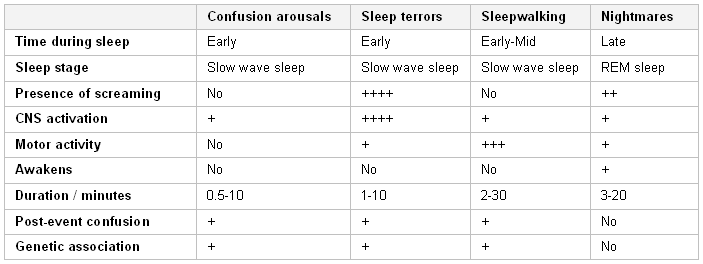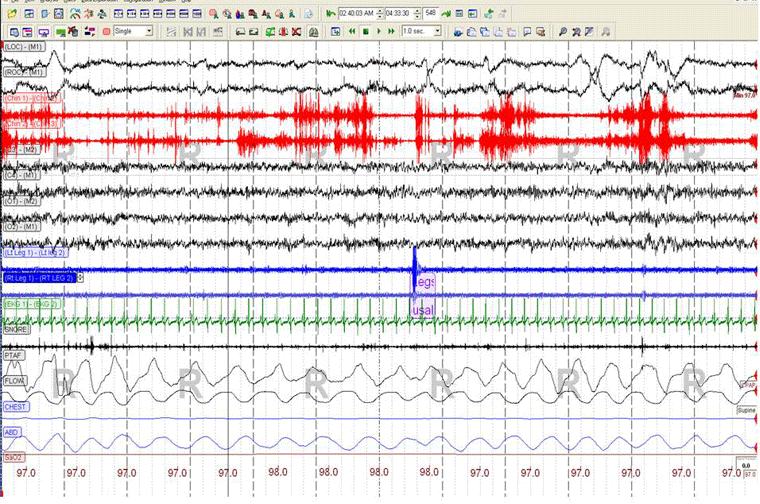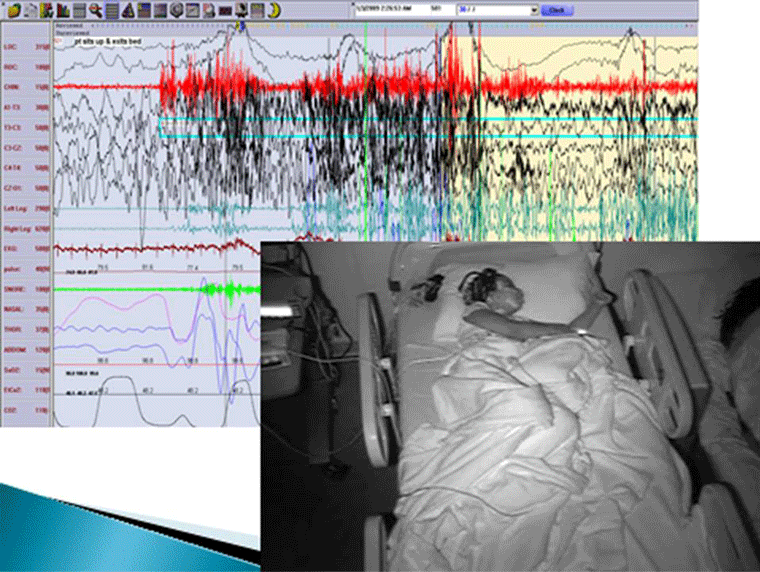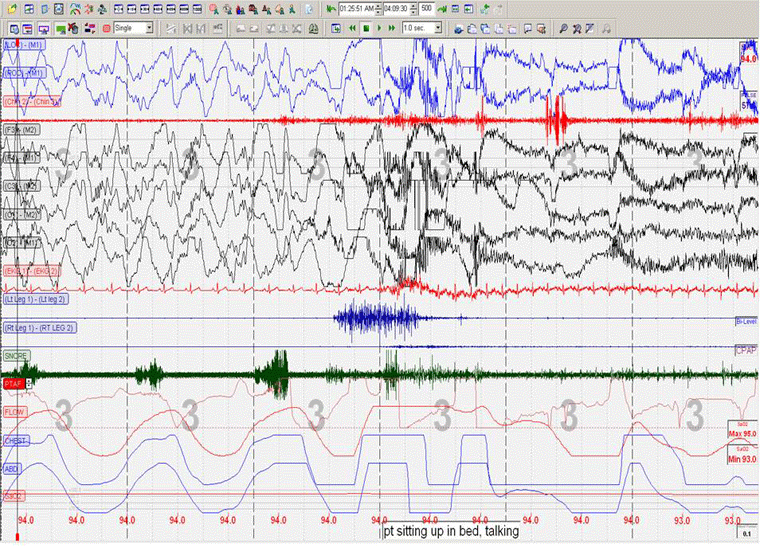Approach
The diagnosis of parasomnia in children is based on a thorough history, usually from the parents and other family members. The utility of subsequent testing depends on careful test selection, based on a strong working diagnosis obtained from the history.[37][48]
Review of risk factors
Children presenting with parasomnias should be screened for other possible comorbid sleep disorders, such as sleep-disordered breathing, restless legs syndrome, and periodic limb movement disorders. These conditions and sleep deprivation may precipitate parasomnias in some children.
It is important to ask about regular sleep patterns and bedtime routines, as sleep deprivation and irregular sleep-wake schedule disorder are associated with parasomnias.[44][49] There may be a family history of parasomnias: sleepwalking, confusional arousal, and sleep terrors are most likely to have occurred in other family members. The presence of the HLA gene DQB1 is strongly associated with sleepwalking.[38]
History should also include inquiry about any known psychiatric disorder or use of psychiatric medication. An underlying psychopathology may play a role in patients with nightmares, and medications such as antidepressants, nonbenzodiazepine hypnotics, and serotonin selective reuptake inhibitors have all been found to be associated with parasomnias.[29] Other risk factors that should be considered include the presence of emotional stress or traumatic life events, occurrence of any forced awakenings, and presence of a fever. The presentation of rapid eye movement sleep behavior disorder (RBD) in children, although very rare, may indicate a new onset of narcolepsy.[21][22][23][24][25][50]
History
When the parents arrive at the bedside, the parasomnia may have already run its course, and the visualization of any signs is incomplete. Siblings who share the bedroom may be able to describe the patient’s symptoms. Occasionally, home videos of night-time events or diaries may be produced by parents and may aid in diagnosis. Generally, children who experience non-rapid eye movement (NREM) parasomnias are witnessed to have disturbed cognition, unusual behaviors, and amnesia, as well as speech difficulties. The more common parasomnias in childhood each have different clinical features, which may help in distinguishing one from another. [Figure caption and citation for the preceding image starts]: Characteristics of major parasomnias in the childFrom the collection of Alon Y. Avidan, David Geffen School of Medicine at UCLA [Citation ends].
Patients with confusional arousals, sleepwalking, sleep terrors, and rapid eye movement sleep behavior disorder (RBD) may be witnessed to have vigorous, bizarre, dramatic, and violent spells. Sleep terrors and nightmares may initially appear similar but can usually be distinguished by the following factors:[49]
Sleep terrors
Autonomic hyperactivity (e.g., tachycardia, tachypnea, pupillary dilation) is commonly a feature
There is partial or total amnesia for the event
Episodes tend to occur earlier at night, when NREM sleep prevails
Difficult to console and the child may push away/reject the person who tries to console him or her.
Nightmares
Occur later at night (during REM sleep)
Children may be able to recall events
Autonomic hyperarousal is less commonly a feature.
Isolated recurrent sleep paralysis is more prevalent in teenagers.[20] Patients describe an episode of inability to move. Careful questioning to distinguish any features of narcolepsy is important in this situation.[21] The management of patients with or without narcolepsy presenting with episodes of recurrent sleep paralysis is different.
Physical exam
General and neurologic examination of patients with parasomnias is typically normal. Evaluation in the ambulatory setting may reveal heightened anxiety, flattened affect as part of a comorbid mood disorder, and, on occasion, even signs of prior bruising and cuts as evidence that the patient injured themselves while sleepwalking.[51][52][53] Children may have a narrowed oropharyngeal airway, which is commonly noted in obstructive sleep apnea.
Polysomnography (PSG)
Most parasomnias can be diagnosed from the clinical history. However, it is important to detect features that require further investigation with PSG.[54] PSG is required for the diagnosis of RBD, and should be used to document complex motor behaviors and vocalizations during REM sleep.[55] PSG may include 1 full night or 2 consecutive nights of monitoring in a sleep laboratory. Simultaneous polysomnographic-audio-video monitoring is essential for such recordings, often with additional physiologic measures beyond the minimum required for standard PSG (e.g., electromyographic measurements may be expanded from only legs to include arms, if RBD is suspected; electroencephalographic measurements may be expanded, particularly if there are features suggestive of epilepsy).[55][56]
Difficulties in diagnosis may arise when attempting to distinguish a parasomnia from a nocturnal seizure, as both phenomena are characterized by a general increase in motor and autonomic activity, along with a transient reduction in the level of consciousness.[57] An additional problem is that an accurate clinical diagnosis generally relies heavily on a detailed history. As sleep-related disorders occur at a time when the patient is not fully cognizant, PSG analysis can, on occasion, supplement for the intrinsic paucity of detailed history.[57]
Patients should be considered for polysomnographic evaluation if:
Presentation is atypical for a parasomnia
Events are contributing to significant injury or have significant potential for injury
Episodes significantly disturb the patient's home life
Episodes have begun or persisted at an unusual age
Events appear stereotypical, repetitive, or unusually frequent; in these cases they are more likely to be representative of nocturnal seizures
There are signs and symptoms of an underlying sleep disorder (e.g., sleep-disordered breathing) or motor disorders of sleep (e.g., periodic limb movement disorder); there may be hypersomnia, insomnia, or rhythmic leg movements present.
Asking parents about their child's symptoms is not an accurate predictor of periodic limb movement disorder (PLMD). PSG with leg electromyography should be used in all pediatric sleep studies when PLMD is suspected.[58] For patients who present with rhythmic movement, diagnosis can be greatly enhanced by documenting suspected nocturnal behaviors with thorough clinical assessment during split-screen, video-polysomnographic analysis.[59][Figure caption and citation for the preceding image starts]: Polysomnography of rapid eye movement sleep behavior disorder (RBD)From the authors' personal collection [Citation ends]. [Figure caption and citation for the preceding image starts]: Polysomnography of sleepwalkingFrom the authors' personal collection [Citation ends].
[Figure caption and citation for the preceding image starts]: Polysomnography of sleepwalkingFrom the authors' personal collection [Citation ends]. [Figure caption and citation for the preceding image starts]: Polysomnography of confusional arousalFrom the authors' personal collection [Citation ends].
[Figure caption and citation for the preceding image starts]: Polysomnography of confusional arousalFrom the authors' personal collection [Citation ends].
Additional investigations
A full polysomnography (sometimes 2 nights) with expanded video EEG monitoring is recommended if the episodes:
Are stereotypic or repetitive
Also occur during the day
Occur frequently (minimum of 1 event per week)
Have not responded to medication trials, and the history is suggestive of potentially epileptic events.
Simultaneously, correlation of the clinical and polysomnographic analysis just prior to, during, and following an event of interest can be very helpful in differentiating nocturnal seizures from parasomnias.[57] Nocturnal frontal lobe epilepsy should be considered in the differential diagnosis of pediatric arousal disorders (e.g., confusional arousals, sleepwalking, and sleep terrors). A urine drug screen is also a reasonable approach in older children if illicit drug use is a possibility.
Use of this content is subject to our disclaimer